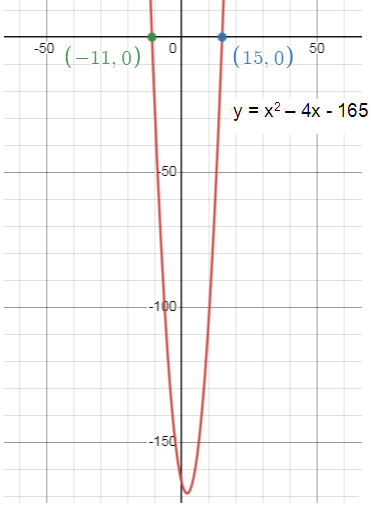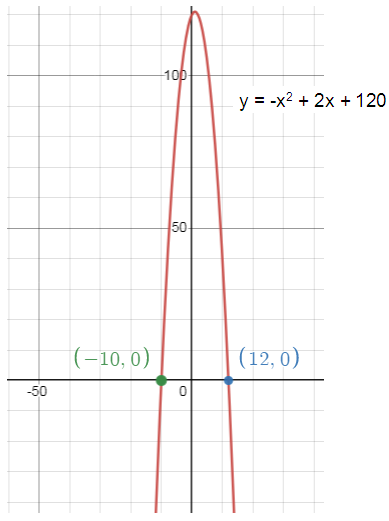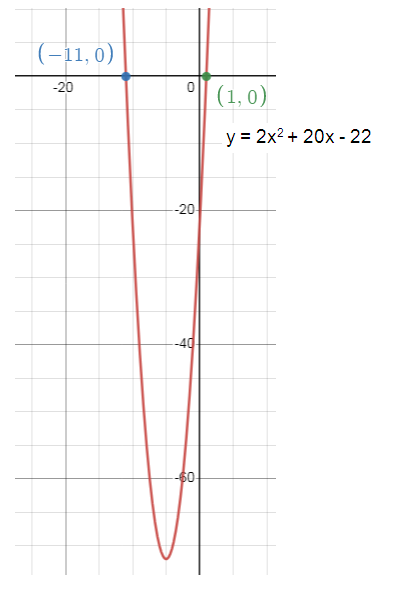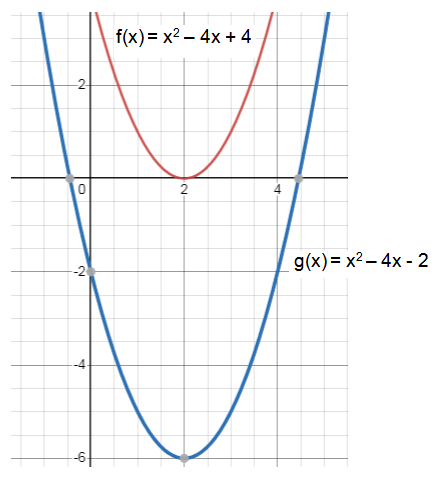CONVERTING QUADRATIC TO VERTEX FORM AND GRAPH
Subscribe to our ▶️ YouTube channel 🔴 for the latest videos, updates, and tips.
Solve the equation by rewriting in vertex (h, k) form. Sketch a graph and label the vertex and x - intercepts.
Problem 1 :
y = x2 - 4x - 165
1. find vertex form 2. find x - intercepts 3. graph completely
Solution :
1. Vertex form
y = x2 - 4x - 165
Using completing the square method,
y = x2 - 2·x·2 + 22 - 22 - 165
y = (x - 2)2 - 22 - 165
y = (x - 2)2 - 4 - 165
y = (x - 2)2 - 169
The vertex form of y = (x - 2)2 - 169
Vertex is at (2, -169)
2. To find x - intercepts
y = x2 - 4x - 165
Put y = 0
x2 - 4x - 165 = 0
x2 + 11x - 15x - 165 = 0
x(x + 11) - 15(x + 11) = 0
(x - 15) and (x + 11) = 0
|
x - 15 = 0 x = 15 |
x + 11 = 0 x = -11 |
x - intercept are (15, 0) and (-11, 0).
3. Graph

Problem 2 :
f(x) = -x2 + 2x + 120
1. find vertex form 2. find x - intercepts 3. graph completely
Solution :
1. Vertex form
f(x) = -x2 + 2x + 120
f(x) = -(x2 - 2x) + 120
f(x) = -(x2 - 2·x·1 + 12 - 12) + 120
f(x) = -[(x - 1)2 - 12] + 120
f(x) = -(x - 1)2 + 1 + 120
f(x) = -(x - 1)2 + 121
The vertex form of f(x) = -(x - 1)2 + 121.
2. To find x - intercepts
f(x) = -x2 + 2x + 120
f(x) = -(x2 - 2x - 120)
-f(x) = x2 - 2x - 120
Put f(x) = 0
x2 - 2x - 120 = 0
x2 + 10x - 12x - 120 = 0
x(x + 10) - 12(x + 10) = 0
(x - 12) and (x + 10) = 0
|
x - 12 = 0 x = 12 |
x + 10 = 0 x = -10 |
x - intercepts are (12, 0) and (-10, 0).
3. Graph

Problem 3 :
y = 2x2 + 20x - 22
1. find vertex form 2. find x - intercepts 3. graph completely
Solution :
1. Vertex form
y = 2x2 + 20x - 22
y = 2(x2 + 10x) - 22
y = 2(x2 + 2·x·5 + 52 - 52) - 22
y = 2[(x + 5)2 - 25] - 22
y = 2(x + 5)2 - 50 - 22
y = 2(x + 5)2 - 72
The coordinates of the vertex is (-5, -72) = (h, k)
2. To find x - intercepts
y = 2x2 + 20x - 22
Put y = 0
2x2 + 20x - 22 = 0
2(x2 + 10x - 11) = 0
x2 + 10x - 11 = 0
x2 - x + 11x - 11 = 0
x(x - 1) + 11(x - 1) = 0
(x + 11) and (x - 1) = 0
|
x + 11 = 0 x = -11 |
x - 1 = 0 x = 1 |
x - intercepts are (-11, 0) and (1, 0).
3. Graph

Problem 4 :
Which correctly identifies the values of the parameters a, h, and k for the function f(x) = -2(x + 3)2 + 1
|
a. a = -2, h = 3, k = 1 b. a = 2, h = -3, k = -1 |
c. a = -2, h = -3, k = 1 d. a = -2, h = -3, k = -1 |
Solution :
Given, function f(x) = -2(x + 3)2 + 1
The vertex form is y = a(x - h)2 + k, where (h, k) are the coordinates of the vertex.
For the given function a = -2, h = -3 and k = 1
So, option c) is correct.
Problem 5 :
Kevin threw a ball straight up with an initial speed of 20 meters per second. The function
y = -5(x - 2)2 + 20
describe the ball’s height, in meters, t seconds after Kevin threw it. What are the coordinates of the vertex ?
|
a. (-5, 2) b. (2, 20) |
c. (20, 2) d. (-5, 20) |
Solution :
Given function is y = -5(x - 2)2 + 20
The vertex form is y = (x - h)2 + k, where (h, k) are the coordinates of the vertex.
The coordinates of the vertex are (2, 20).
So, option b) is correct.
Problem 6 :
Which equation describes a parabola that opens downward, is congruent to y = x2, and has its vertex at (0, 3) ?
Solution :
The vertex of the parabola is at (0, 3).
Because the constant term in the equation represents the y-coordinate of the vertex.
Given, y = x2
y - 3 = -(x - 0)2
y - 3 = -x2
y = -x2 + 3
Problem 7 :
Which of following functions does NOT represent the parabola with a vertex at (1, 4) and x – intercepts (-1, 0) and (3, 0).
|
A. f(x) = -x2 + x + 4 B. f(x) = -(x - 1)2 + 4 |
C. f(x) = -x2 + 2x + 3 D. f(x) = –(x2 – 2x - 3) |
Solution :
Let us consider the quadratic function as
y = a(x - h)2 + k
y = a(x - 1)2 + 4
Applying x-intercepts, (1, 0) and (3, 0)
0 = a(3 - 1)2 + 4
0 = a(4) + 4
-4 = 4a
a = -1
y = -1(x - 1)2 + 4
Problem 8 :
Given the function,
f(x) = x2 + 10x + 23
state whether the parabola opens up or down and the maximum or minimum value.
Solution :
Given the function, f(x) = x2 + 10x + 23
The equation of a parabola which will open upward (because of the positive coefficient of x2)
So, it will have a minimum value.
Problem 9 :
Compare the functions, f(x) and g(x), and explain how the graph of f(x) = x2 – 4x + 4 is related to the graph of g(x) = x2 – 4x - 2.
A. f(x) is vertically stretched to make g(x)
B. f(x) is translated 6 units left to make g(x)
C. f(x) is translated down 6 units to make g(x)
D. f(x) is compressed vertically to make g(x)
Solution :
|
f(x) = x2 – 4x + 4 = (x - 2)2 – 4 + 4 = (x - 2)2 |
g(x) = x2 – 4x - 2 = (x - 2)2 – 4 - 2 = (x - 2)2 - 6 |
Translating down 6 units.

Subscribe to our ▶️ YouTube channel 🔴 for the latest videos, updates, and tips.
Recent Articles
-
Finding Range of Values Inequality Problems
May 21, 24 08:51 PM
Finding Range of Values Inequality Problems -
Solving Two Step Inequality Word Problems
May 21, 24 08:51 AM
Solving Two Step Inequality Word Problems -
Exponential Function Context and Data Modeling
May 20, 24 10:45 PM
Exponential Function Context and Data Modeling